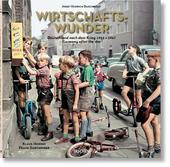
|
Josef Heinrich Darchinger. Wirtschaftswunder
Hardback
Main Details
| Title |
Josef Heinrich Darchinger. Wirtschaftswunder
|
| Authors and Contributors |
By (author) Klaus Honnef
|
|
Edited by Frank Darchinger
|
|
Photographs by Josef Heinrich Darchinger
|
| Physical Properties |
| Format:Hardback | | Pages:292 | | Dimensions(mm): Height 293,Width 293 |
|
| Category/Genre | Individual photographers |
|---|
| ISBN/Barcode |
9783836589277
|
| Classifications | Dewey:778.999 |
|---|
| Audience | |
|---|
| Edition |
Bilingual edition
|
|
Publishing Details |
| Publisher |
Taschen GmbH
|
| Imprint |
Taschen GmbH
|
| Publication Date |
23 October 2021 |
| Publication Country |
Germany
|
Description
It was no more than eight years after the surrender of the Nazi government when Josef Heinrich Darchinger set out on his photographic journey through the West of a divided Germany. The bombs of World War II had reduced the country's major cities to deserts of rubble. Yet his pictures show scarcely any signs of the downfall of a civilization. Not that the photographer was manipulating the evidence: he simply recorded what he saw. At the time, a New York travel agency was advertising the last opportunity to go and visit the remaining bomb sites. Darchinger's pictures, in color and black-and-white, show a country in a fever of reconstruction. The economic boom was so incredible that the whole world spoke of an "economic miracle." The people who achieved it, in contrast, look down-to-earth, unassuming, conscientious, and diligent. And increasingly, they look like strangers in the world they have created. The photographs portray a country caught between the opposite poles of technological modernism and cultural restoration, between affluence and penury, between German Gemutlichkeit and the constant threat of the Cold War. They show the winners and losers of the "economic miracle," people from all social classes, at home, at work, in their very limited free time and as consumers. But they also show a country that looks, in retrospect, like a film from the middle of the last century. For this revised edition, we have digitally remastered all photographies in a new, full-frame format that captivate with their highly pigmented colors and fine press varnish.
Author Biography
Klaus Honnef was honorary professor of photography theory at the Kassel Art Academy. He was one of the organizers of documenta 5 and documenta 6 in Kassel, and has been the curator of more than 500 exhibitions in Germany and abroad. He has written numerous books, including TASCHEN's Contemporary Art, Andy Warhol, and Pop Art. In 1977, Frank Darchinger began his career as a photojournalist, while also assisting his father, Josef Heinrich Darchinger, with the classifying and updating of his legendarily vast and efficient photographic archive. It was through his endeavors that his father's work has become accessible to the general public. Today Frank Darchinger works as a freelance photographer in Bonn. Josef Heinrich Darchinger (1925-2013) started working as a freelance photojournalist in 1952. Darchinger's photographs began to regularly appear in reputable German print media starting in the mid-1960s. In his years as a photographer for Der Spiegel and Die Zeit, Darchinger had a formative influence on the magazines' national news coverage of Bonn. He also presented his work at exhibitions and in collections of photographic portraits-for instance of Helmut Schmidt, Willy Brandt, Richard von Weizsacker, or Heinrich Boell. Darchinger received numerous awards, among which was the prestigious Erich Salomon Award from the German Photographic Association.
ReviewsA critic once said that Darchinger could think with his eyes. The photographs in the book Wirtschaftswunder prove that he can also feel and speak with them. * Der Spiegel *
|